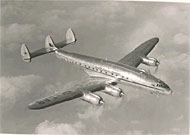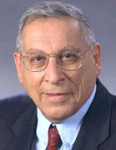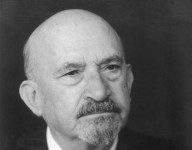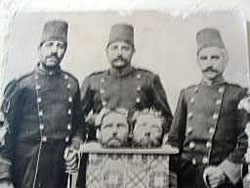 The Armenian genocide refers to the deliberate and systematic destruction (genocide) of the Armenian population of the Ottoman Empire during and just after World War I. It was implemented through wholesale massacres and deportations, with the deportations consisting of forced marches under conditions designed to lead to the death of the deportees. The total number of resulting Armenian deaths is generally held to have been between one and one and a half million.
The Armenian genocide refers to the deliberate and systematic destruction (genocide) of the Armenian population of the Ottoman Empire during and just after World War I. It was implemented through wholesale massacres and deportations, with the deportations consisting of forced marches under conditions designed to lead to the death of the deportees. The total number of resulting Armenian deaths is generally held to have been between one and one and a half million.
The atrocities committed against the Armenian people of the Ottoman Empire during W.W.I. are called the Armenian Genocide. Genocide is the organized killing of a people for the express purpose of putting an end to their collective existence. Because of its scope, genocide requires central planning and a machinery to implement it. This makes genocide the quintessential state crime, as only a government has the resources to carry out such a scheme of destruction. The Armenian Genocide was centrally planned and administered by the Turkish government against the entire Armenian population of the Ottoman Empire. It was carried out during W.W.I. between the years 1915 and 1918.
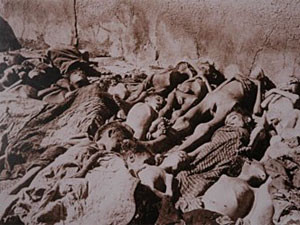
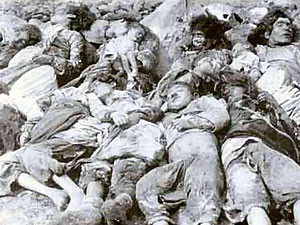 The Armenian people was subjected to deportation, expropriation, abduction, torture, massacre, and starvation. The great bulk of the Armenian population was forcibly removed from Armenia and Anatolia to Syria, where the vast majority was sent into the desert to die of thirst and hunger. Large numbers of Armenians were methodically massacred throughout the Ottoman Empire. Women and children were abducted and horribly abused. The entire wealth of the Armenian people was expropriated. After only a little more than a year of calm at the end of W.W.I., the atrocities were renewed between 1920 and 1923, and the remaining Armenians were subjected to further massacres and expulsions. In 1915, thirty-three years before THE UN Genocide Convention was adopted, the Armenian Genocide was condemned by the international community as a crime against humanity.
The Armenian people was subjected to deportation, expropriation, abduction, torture, massacre, and starvation. The great bulk of the Armenian population was forcibly removed from Armenia and Anatolia to Syria, where the vast majority was sent into the desert to die of thirst and hunger. Large numbers of Armenians were methodically massacred throughout the Ottoman Empire. Women and children were abducted and horribly abused. The entire wealth of the Armenian people was expropriated. After only a little more than a year of calm at the end of W.W.I., the atrocities were renewed between 1920 and 1923, and the remaining Armenians were subjected to further massacres and expulsions. In 1915, thirty-three years before THE UN Genocide Convention was adopted, the Armenian Genocide was condemned by the international community as a crime against humanity.
How many people died in the Armenian Genocide?
It is estimated that one and a half million Armenians perished between 1915 and 1923. There were an estimated two million Armenians living in the Ottoman Empire on the eve of W.W.I. Well over a million were deported in 1915. Hundreds of thousands were butchered outright. Many others died of starvation, exhaustion, and epidemics which ravaged the concentration camps. Among the Armenians living along the periphery of the Ottoman Empire many at first escaped the fate of their countrymen in the central provinces of Turkey. Tens of thousands in the east fled to the Russian border to lead a precarious existence as refugees. The majority of the Armenians in Constantinople, the capital city, were spared deportation.
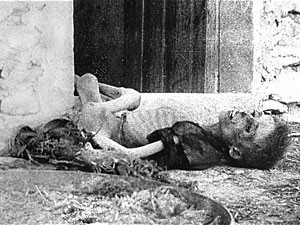
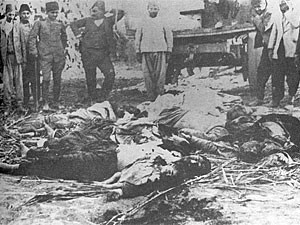 1918, however, the Young Turk regime took the war into the Caucasus, where approximately 1,800,000 Armenians lived under Russian dominion. Ottoman forces advancing through East Armenia and Azerbaijan here too engaged in systematic massacres. The expulsions and massacres carried by the Nationalist Turks between 1920 and 1922 added tens of thousands of more victims. By 1923 the entire landmass of Asia Minor and historic West Armenia had been expunged of its Armenian population. The destruction of the Armenian communities in this part of the world was total.
1918, however, the Young Turk regime took the war into the Caucasus, where approximately 1,800,000 Armenians lived under Russian dominion. Ottoman forces advancing through East Armenia and Azerbaijan here too engaged in systematic massacres. The expulsions and massacres carried by the Nationalist Turks between 1920 and 1922 added tens of thousands of more victims. By 1923 the entire landmass of Asia Minor and historic West Armenia had been expunged of its Armenian population. The destruction of the Armenian communities in this part of the world was total.
Who was responsible for the Armenian Genocide?
The decision to carry out a genocide against the Armenian people was made by the political party in power in the Ottoman Empire. This was the Committee of Union and Progress , popularly known as the Young Turks. Three figures from the CUP controlled the government; Mehmet Talaat, Minister of the Interior in 1915 and Grand Vizier (Prime Minister) in 1917; Ismail Enver, Minister of War; Ahmed Jemal, Minister of the Marine and Military Governor of Syria. This Young Turk triumvirate relied on other members of the CUP appointed to high government posts and assigned to military commands to carry out the Armenian Genocide. In addition to the Ministry of War and the Ministry of the Interior, the Young Turks also relied on a newly-created secret outfit which they manned with convicts and irregular troops, called the Special Organization (Teshkilati Mahsusa). Its primary function was the carrying out of the mass slaughter of the deported Armenians. In charge of the Special Organization was Behaeddin Shakir, a medical doctor. Moreover, ideologists such as Zia Gokalp propagandized through the media on behalf of the CUP by promoting Pan-Turanism, the creation of a new empire stretching from Anatolia into Central Asia whose population would be exclusively Turkic. These concepts justified and popularized the secret CUP plans to liquidate the Armenians of the Ottoman Empire.
The Young Turk conspirators, other leading figures of the wartime Ottoman government, members of the CUP Central Committee, and many provincial administrators responsible for atrocities against the Armenians were indicted for their crimes at the end of the war. The main culprits evaded justice by fleeing the country. Even so, they were tried in absentia and found guilty of capital crimes. The massacres, expulsions, and further mistreatment of the Armenians between 1920 and 1923 were carried by the Turkish Nationalists, who represented a new political movement opposed to the Young Turks, but who shared a common ideology of ethnic exclusivity.
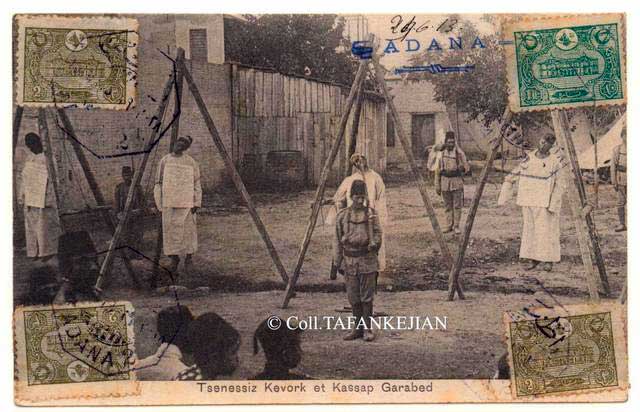
Source: Armenian National Institute, Inc.


